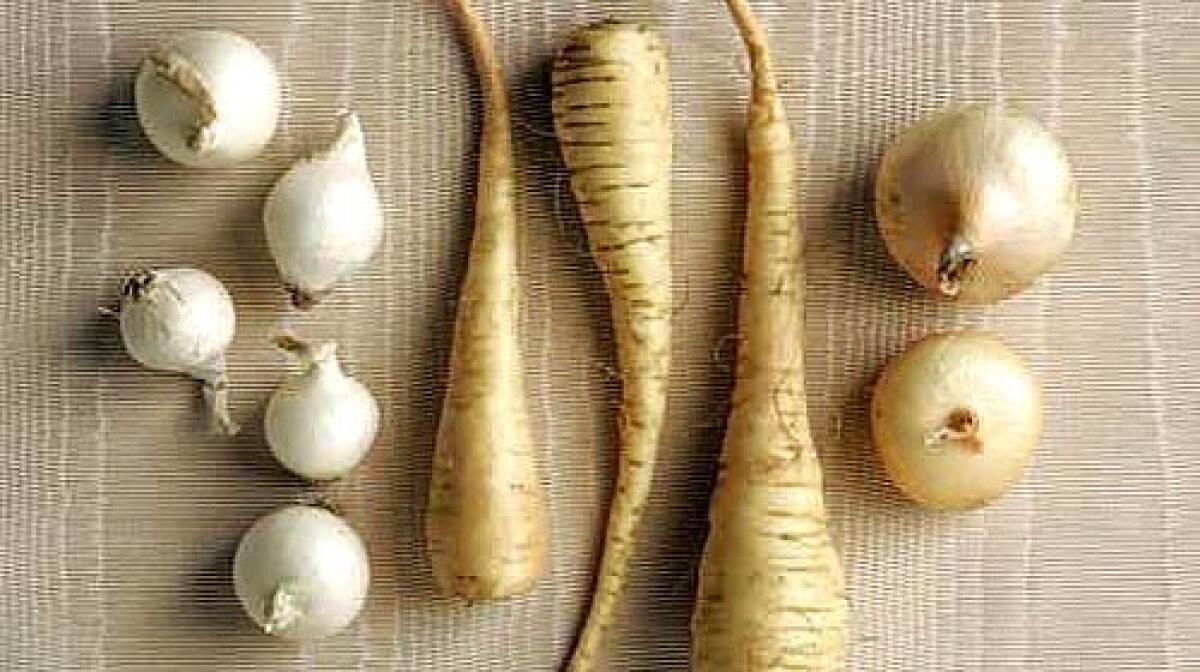Smooth and sophisticated shades of pale

TINY pearl onions, pale and round and almost as iridescent as their namesakes. The layered ivory of cipollini, braised to a melting tenderness. Miniature white parsnips and fingerling potatoes, roasted in their light matte coats.
The absence of color, once prized in French cooking, is now a relative rarity in a big dinner, especially the richly hued harvest feast that is Thanksgiving. But particularly on such a table, a bowl of mashed potatoes or a soothing gratin of celery root can be like brief moments of calm amid the dinner’s beautiful storm.
Potatoes and onions are most ubiquitous, hidden in stuffings, lacing soups or stocks, adding a key note to more than half of the dishes at this holiday. Yet there’s a particular charm to these kitchen workhorses -- and to leeks and parsnips, celeriac and the pale inner workings of celery hearts -- that sometimes calls for a bit of showcasing. What better time than this to set them center-stage?
Take the delicate flavor of a parsnip, which has a subtle minerality born from the earth in which it grows, and let it shine on its own. Roast a pan of the baby vegetables and serve them with only with a confetti of parsley. Or roast baby potatoes, then smash them for a luxurious, velvety side dish. A little butter and sea salt are all they need. You can team them with roasted garlic and shallots too, even a little crème fraîche or horseradish. The palette of colors will be the same, but your palate will definitely note the difference.
These are vegetables that either come from under the ground or grow low to it. Though their pale hue may indicate a lack of long hours in the sun, it certainly doesn’t mark a lack of flavor. Either rich and aromatic like the members of the onion family, or subtler in tone like potatoes or parsnips, these ivory beauties can stand on their own -- or work together.
And if you want something a little different than roasting or mashing, try a gratin. Just arrange sliced root vegetables in a baking dish, bathe them in a mixture of cream and cheese, and bake them until the interior is tender and bubbly, the top a lovely golden carapace.
This method is fantastic with potatoes, but also with the more uncommon celery root, or even a mix of root vegetables. Tired of the same old russets? Try rutabagas, turnips, even salisfy.
You can spice things up a bit too. In addition to fresh herbs, add whole-grain mustards, freshly grated nutmeg, Tellicherry or Aleppo pepper.
Purées are also a good fit for the holiday menu, and a nice variation from the usual bowl of mashed vegetables. You can turn them into stunning soups too, smooth and sophisticated yet incredibly easy (a bonus given the often frenzied final hours of cooking). Just purée cooked root vegetables with a healthy pour of milk or stock, adding cream if you want it richer, water to take it light. Jazz it up with spices or a dose of pepper, then sprinkle with a confetti of fresh herbs or a tangle of fried leeks.
Roasted or mashed, puréed or gratineed, the vegetables on the pale side of the Thanksgiving spectrum share an often subtle quality that’s easily overlooked. So instead of relegating them to a side role, push them quietly to the center of the table.
There, alongside the abundant colors of the harvest celebration, their pale fire may burn brighter than you’d think.
amy.scattergood@latimes
.com
More to Read
Sign up for our L.A. Times Plants newsletter
At the start of each month, get a roundup of upcoming plant-related activities and events in Southern California, along with links to tips and articles you may have missed.
You may occasionally receive promotional content from the Los Angeles Times.







